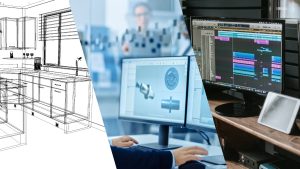Digital twin technology transforms the world with incredible real-like visibility of the current and simulated conditions of expensive assets and infrastructure. Simulative digital twin models have allowed industry experts to gain marvellous momentum in saving hoards of money, months’ worth of time and avoiding risks.
However, a handful of industrial giants are still not using the power of digital twin environments to use real-world simulations the right way to pinpoint optimisation opportunities. The market for digital twins is relatively small compared to other digital visualisation tools. But IIoT advancements and digitisation of industrial systems make the adoption of digital twin systems less of a hassle. Before investing in a digital twin, you should understand the uniqueness of utilising a virtual model to aid asset management and optimising business operations.
This article is written to help the reader understand the difference between a 3D and 4D digital twin and the uses of 4D digital twins to optimise the industrial computer vision of the modern industrial leaders of the digital age.
Difference Between a 3D and 4D Digital Twin Model
The digital model is commonly defined as the bridge between the virtual and physical worlds. A digital twin is a system that is an interactive visualisation tool that allows the user to manipulate a virtual replica of a physical ‘thing’- engines, machines, infrastructure, robots, production lines or even factories, buildings or cities. In essence, the digital twin is a system that uses real-world data to simulate the actual conditions, parameters and indexes of physical components. They use data from data-rich points like databases, clouds, satellites, applications, sensors, smart machines etc., via IoT systems. The abundance of data collected and standardised are later fed to analytical software powered by AI to enhance output- actionable insights and intelligence- that is visualised into interactive models.
So how are 3D digital twin systems any different from 4D digital twin systems? There is one disparity between 3D and 4D digital twin environments- that is ‘Simulative Capability’. In other words, compared to a conventional 3D twin, the 4D twin system has an extra dimension: Time. Most digital twin environments allow asset managers, engineers and other asset decision-makers to utilise the virtual model to read asset conditions, performance, criticalities and risks in real-time. But, 4D digital twin technology allows the user to investigate asset conditions using time-related scheduling data.
4D Digital Twin in Practice
4D digital twin systems allow asset specialists to simulate digital twin models to represent virtual construction sequences of an asset over time. The user can play with the parametric scales and key in different indexes to represent the asset condition at any given time or event. This will help the user to run as-built situations or ‘what if’ asset scenarios to learn about asset behaviours over time. The event-driven analytical perspective given by digital twin systems allows gaining granular level insights. The following are a few hypothetical questions that asset-heavy industrial leaders in the water, wastewater, road and mechanical industry can ask from 4D digital twin systems:
- What is the asset integrity index of a dam infrastructure at a peak flood discharge of 500 m3/s located in a wet zone?
- How will the CRZ (Critical Root Zone) of trees in ‘City X’ affect the wastewater pipelines after 20 months?
- How would a road conditions index and pavement index degrade after 4 hours of peak traffic per day?
- How many investments will a mechanical asset cost in maintenance and renewal for the next 5 years?
As fascinating as it is, 4D digital twin systems, if implemented right, can answer far more complex asset dilemmas with data-driven insights in a matter of a split second.
Difference Between a 3D and 4D Digital Twin Model
With time and more complex user requirements, the sophistication and capabilities of digital twin systems have advanced profoundly. Digital twin technology is now a staple visualisation tool for modern asset management and engineering to improve industrial performance and drive innovation across industrial longitudes and latitudes. Many asset-oriented industrial leaders are investing more in digital twin environments, but harnessing the power of 4D digital twin systems truly brings out the ultimate visualisation capacity of modern asset utilisers. This is why you should never miss out on learning how simulative digital twin models can optimise your asset management efforts inside out while saving hoards of organisational time, money and effort in balancing the risk, cost and performance of assets across your industrial plane.







